NoLand RS11, analog to NMEA 2000 engine monitoring
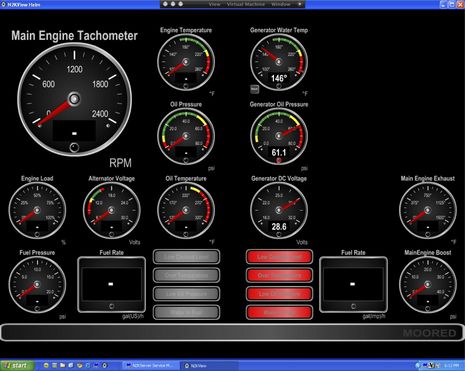
What follows is a first time guest entry by regular Panbo commenter Adam Block, who is planning a 2011 Pacific
crossing aboard his Nordhavn 47 Convexity. Adam says “he had no idea what he was getting into when he started a recent electronics upgrade,” but he did manage to convert analog (generator) engine data into NMEA 2000 for display in the N2KView software above and elsewhere. He’s also written a clear explanation of the options available for this tricky task, and the specifics of the NoLand RS11 he used…
Having completed the primary electronics refit on Convexity,
I’m deep into the secondary projects – nice-to-haves
like external IP
cameras and
centralized systems monitoring. I’m using Maretron N2KView
software for monitoring, but any modern NMEA 2000 digital gauge —
Maretron’s own
DSM250 or the Garmin GMI 10, Raymarine ST70, or the “coming
soon” Furuno RD33 — can display a wide range of data about onboard
systems
ranging from engines to battery banks.
Today
I’m thinking about engine data. Though Convexity
has a single primary engine, we actually have three diesel motors on
board. The
other two are a wing (get-home) engine and a 12 kW generator. Getting
engine
data onto the NMEA 2000 bus (and from there onto one of those displays)
can be easy
or hard, depending on the kind of motor you have. Owners of larger
outboards
have it easy: Mercury, Suzuki, Yamaha, Evinrude, and Honda all output
lots of
engine parameters in NMEA 2000 format, though you may need a funky
wiring
harness or digital gauge to make the backbone connection.
In general the same can be said for modern
electronically-controlled diesel prime movers; most support an engine
data
protocol called J1939 that runs over the familiar industrial CanBUS
(which
happens to be the same wiring and communications standard on which NMEA
2000 is
based). J1939 can be used to exchange data between two engines (to
synchronize
RPMs on a twin-engine vessel, for example) or to drive physical gauges —
Convexity’s
analog-looking engine gauges actually receive digital signals via
CanBUS. J1939
engine messages aren’t the same as NMEA 2000 engine messages, but
Maretron
offers the J2K100
converter box to bridge the two networks together. (It’s a one-way
bridge: the
J2K100 passes J1939 data from the engine network to the NMEA 2000 bus,
but no
information flows the other way).
That’s all fine for folks with brand new boats, you
say, but
what about the thousands of sail- and powerboat owners with older
engines that
lack electronic fuel injection and the engine computer needed to output
digital
performance data? Or in my case, what about my Lugger wing engine and
Northern
Lights generator, neither of which supports digital gauges? If I’m
adding a
complete monitoring system to the boat, it seems wrong to exclude them.
(This
is especially true of the generator, as its gauge package is in a
hard-to-see
location near the top of the stairs to the staterooms.)
It took some research, but I came up with three
possible
solutions for getting NMEA 2000 data out of my analog engines:
- Maretron
EMS100:
This analog adapter is designed for Yanmar engines, and Maretron doesn’t
currently certify its use with motors from any other manufacturer. They
did helpfully send me a Yanmar engine wiring diagram in case I wanted to try
and make up the required harness on my own, but one look at the diagram’s
maze of lines quickly put me off that idea. - NoLand Engineering
RS11:
Browsing through the 2010 Gemeco catalog, I stumbled on a product (and
manufacturer) I’d never heard of. NoLand is a small Florida outfit that
makes a
variety of mostly NMEA 0183 splitters and multiplexers. Their new RS11
converts
the voltage signals many analog engines use to drive gauges into NMEA
2000
PGNs. The RS11 can be configured for a range of different input types
and at
$230 is a relative bargain. - Albatross
ALBA-Engine:
Albatross is a Spanish company that makes some interesting NMEA 2000
sensors
and interfaces (they also appear to distribute NMEA 2000 devices from
nearly
all the other big names in this category, including Actisense, Maretron,
and
Airmar). Unlike the RS11, the ALBA-Engine works with either resistive or
voltage senders. But Albatross is hard to find in the U.S., and their
stuff is
correspondingly expensive – the ALBA-Engine costs nearly $500. {Panbo discussion and slide show here.}
Based on price and capabilities — my gauges are
voltage-based
— the RS11 seemed a good fit. I ordered direct from the NoLand web site,
and
the unit arrived about a week later. In the box was a small circuit
board with
a terminal strip on one side and an attached NMEA 2000 drop cable, a
serial
cable (the RS11 needs to be programmed before use via Windows PC), a
somewhat
flimsy-feeling plastic circuit board cover, and one of those business
card-sized CD-ROMs that only work in slot-loading drives.
You can wire the RS11 directly to your engine, but I
found
it much simpler to connect to the back of the engine gauges themselves;
all of
the pickups are in one place, and I prefer to work in the comfort of the
pilothouse than the confines of the engine room. I started on the
generator
first. All of the gauges have standard male disconnects on the back. The
quick
and dirty approach for small gauge sense wires — I used a short length
of
8-conductor 18-gauge Ancor data cable — is to just bend the conductor
over the
disconnect tab and then press the female connector on the engine wire
down over
the tab. This approach won’t pass any good electronics installer’s
muster,
though, and probably violates half a dozen ABYC regulations; the right
way is
to use a standalone
piggyback
adapter, or a female
disconnect
with a piggyback connector as shown in the photo below. The RS11
needs only a single sense wire per gauge, which normally connects to the
‘S’
pin on the gauge body; as a ground reference it uses the ground pin of
the
attached NMEA 2000 cable. The NMEA 2000 bus supplies power to the unit.
Engines and their gauges vary widely, so before it
will
output accurate data you have to calibrate the RS11 using the somewhat
rudimentary Windows application shown below. The terminal strip has two
tachometer inputs and four analog inputs. With some limitations, the
analog
inputs can be used to monitor any of the following: oil pressure; oil
temperature; engine (coolant) temperature; coolant pressure; fuel
pressure;
alternator voltage; turbo boost; and tilt/trim. Not all engines will
output all
of this data, and with only four inputs you’ll have to choose which of
these
are most important. (The RS11 can also be connected to two separate
engines, in
which case you divide the four inputs between the two engines.)
Monitoring RPM requires knowing the number of
“pulses per
revolution” output by the engine. This varies depending on the engine
type, and
the RS11’s manual does a pretty good job explaining what information you
need
to properly calibrate the unit. In my case I needed to know the number
of teeth
on the flywheel; a quick inquiry to Lugger provided the answer (126),
which I
entered into the configuration utility.
Analog calibration is a bit more complex. The RS11
operates
on the principle that there is a direct straight-line relationship
between
voltage at the back of the gauge and the actual value being monitored.
In order
to determine this relationship, you enter two voltages and actual values
into
the calibration software, which then derives the proper formula (in the
form value
= m � voltage + b,
where m
and b are constants) from the supplied data. For example, in the
case of
engine coolant temperature my measurements were as follows:
Actual temperature #1: 58� F
Measured voltage #1: 6.20V
Actual temperature #2: 110� F
Measured voltage #2: 2.33V
Collecting these numbers can be a bit of a chore,
especially
if they are changing as you measure them. In the case of the engine
temperature, I assumed that “actual temperature #1” was simply the
ambient
temperature of the engine room before I started the engine (it had been
shut
down for a few days). I turned on power to the engine and probed the
back of
the gauge with my multimeter to determine “measured voltage #1”. For
“actual
temperature #2” I started the engine and waited for it to warm up enough
to
show a reading on the analog gauge. I probed the voltage at the same
time as I
read the temperature off the gauge, and entered the second set of
numbers into
the configuration utility. Needless to say, analog gauge accuracy,
parallax, and
timing all contribute to the quality of the calibration. Values that
don’t
change much over time, such as oil pressure, are easier to calibrate.
With the calibration data entered into the
configuration
utility, it was time to download it to the RS11. I had some trouble
here: the
RS11 refused to accept the new settings. NoLand’s head engineer
suggested that
a reboot or two (disconnect the NMEA 2000 cable to cut the power, then
reconnect) should fix the problem, and it did. Seconds later my
generator’s temperature,
oil pressure, and output voltage popped up on the Maretron N2KView
screen (seen at the top of the entry).
As you can see, my calibration was pretty good, as
the
displayed values closely track the analog gauges:
Final mounting of the RS11
interface was easy due to its small size (3″ x 3.75″)
and light weight; I simply mounted it to the back of the breaker cabinet
and
cinched down the cables:
With
a little patient calibration, the RS11 is easy to install and works as
promised, though I did have a couple of issues. First, on at least one
occasion
the RS11 seemed to lose its sensing capabilities. After I left the
engine shut
off for a few days (but the NMEA 2000 network, and thus the RS11, still
powered
up), when I restarted the engine the unit sent no engine data. Rebooting
the
RS11 cleared up the problem but it’s something I’ll be keeping an eye
on.
My
other issue arose from the nature of the algorithm the RS11 uses to
calibrate
analog voltages. Some analog gauges use inverse voltage; that is, when
the
voltage from the engine’s sender drops, the value displayed on the gauge
increases. This is the case for our generator’s coolant water
temperature. When
the RS11 is calibrated, the formula it derives for this kind of gauges
has a
negative slope (that is, in that equation above, y is negative).
The
problem arises when the engine is turned off, and the voltage measured
by the
RS11 is zero. This zero voltage is spurious – it’s not a true output
from the
engine, but an artifact of the engine being off – but based on the
formula in
the RS11 it appears that the temperature is very high. In our case the
N2KView
gauge reads 254� when the engine is shut down. I spoke to NoLand about
this
issue, and suggested that the unit sense when it the attached engine is
off.
Their chief engineer confirmed they would like to add that feature – one
I
believe the ALBA-Engine does have – but that working within the
limitation of
the small amount of memory on the RS11’s circuit board was a challenge.
How about a Panbo round of applause for Adam Block {ed}





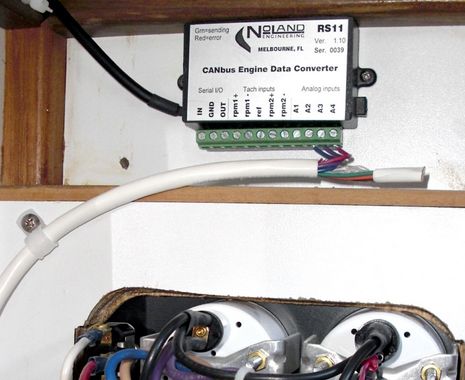
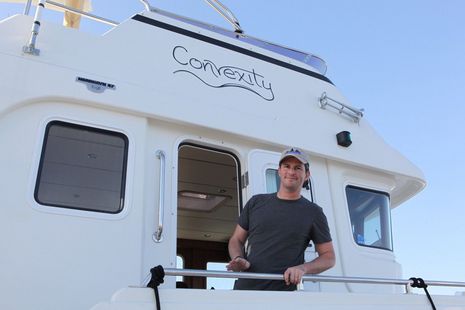
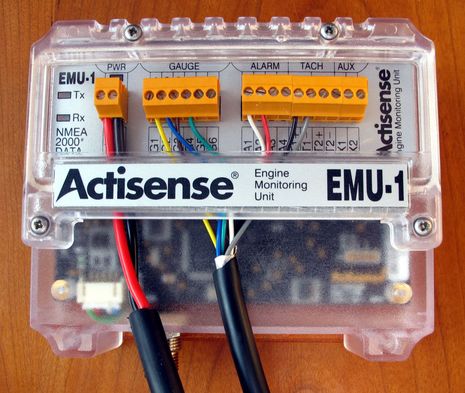
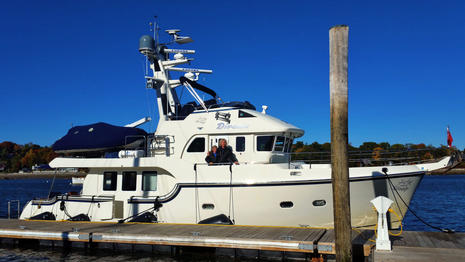
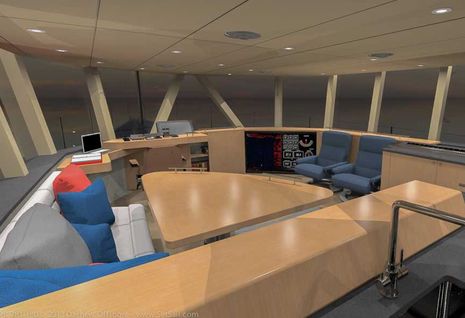
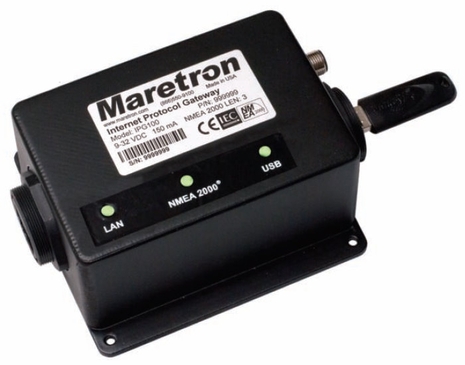








Adam,
congratulations on this great, and detailed not only presented but more important tested RS11.
Thanks!
Well done!
AND thank you for your contribution!
hey adam
i just install this unit also
i have serie number 37 haha just 2 below you
every thing works fine i think
i instalt it on a old perkins moter on a sailboat
but i have have only engine temp and not his water temp so my data comes in a other gauge in the display
for the rest i need to finetune it
rpm i have almost good
engine temp i copy the preset settings
oil press also to bad that it dont have bars
engine volts this i dont have yet working (dont know why yet)
and i testit on a gmi 10 and soon on a gpsmap 5012
Adam,
Congrats on getting this working.
However, I am a bit worried about the way the Noland uses the N2K 0V level as ground reference. Certainly it could be the case that the 12V supply to the CANbus is at a different potential than that of the engine. In my boat this is certainly the case as the 12V supply is generated by a DC-DC converter with floating output. Also, all three inputs need to have the same ground reference. I don’t think the NMEA approves of this, and I’d have to agree with them.
The diagrams for the ALBA Engine indicate that they do it correctly i.e. have separate wiring inputs for all negatives.
IMO the added safety and reliability the more elaborate circuit in the ALBA engine provides would be worth the price difference.
The RS11 looks like a very interesting piece of equipment for those of us with analog gauges. However, as a software developer I can’t understand the seeming oversight of not designing the thing with enough memory. Memory is about as cheap and dense as it has ever been and there is just no reason for them to skimp in that department. It’s things like this that make me hesitate to buy something from a company. If they cut corners on memory capacity, where else did the cut corners?
Kees: I hear what you are saying and I was indeed a bit surprised to find that the RS11 was designed this way. In fact, I had to call NoLand to ask where the ground references were! So far I have not seen a case where a deviation between ground voltages caused a gauge inaccuracy. However, I could see this being of particular concern if you were using the RS11’s output as a primary indicator on a critical system. It’s not clear to my why NoLand would make this choice, unless there are simply too few A/D inputs on whatever chip they are using.
That kind of ties into sailoutbound’s comment. I should note that if I understood correctly, the NoLand engineer was explaining that much of the chip memory was used to store the conversion algorithms needed by the various PGNs (different units of pressure, temperature, etc.). Upon reflection that further confused me, because I thought that N2K allowed a sentence to be specified in a single unit (Celsius or kPa, say) and that the display (listener) was responsible for any unit conversion. If that is indeed the case then it seems all of the calibration could be done in the RS11 config utility.
Perhaps NoLand can comment, if they read Panbo.
Pascal, if the config utility doesn’t have bars you should be able to pretty easily use another unit. I think it has kPa and 1 bar = 100 kPa.
As for voltage, I’m surprised you’re having an issue as voltage is the easiest calibration to make as it’s 1:1 between input and output. I didn’t bother measuring voltage, just entered 0:0 and 20:20 as my voltage/value pairs.
I should also mention that the first step in the system calibration is choosing the voltage range for your gauges and then setting the voltage divider jumpers on the circuit board to match. The voltage ranges for the gauges can be set to 5V, 10V, 15V, 20V, or 30V. I used 0-10V for everything except my alternator output, which was 0-30V.
It should be noted that the RS11 is not NMEA 2000 certified. That doesn’t mean it won’t work without problems, but it does mean that it hasn’t been tested with NMEA’s certification software and that it may do things in ways NMEA doesn’t approve of.
I just emailed NoLand, hoping they’ll participate in this conversation one way or another.
Thank you Adam. You have given me hope to do a similar project on my boat after I return From Alaska and the Inside Passage in September.
My situation is different in that I have a modern electronic Cummins engine, a Raymarine E120 chart plotter, and SmartCraft gauges. It may be modern, but I have no documentation, the customer support is friendly, but they do not have a clue.
Some where on the engine is a place I can tap into the J1939 data, I was told by Cummins support that there was a NMEA plug on my SmartCraft harness. Getting the NMEA 2000 data into the Raymarine E120 display looks simple, but expensive as I do not have a NMEA 2000 device.
So I am taking a break enjoying the fishing and crabing.
Patrick Harman
Kees – I have worked on numerous diesel engines and my recollection is that none of them have the negative side of the instruments flowing through the engine for analog gauges. Most of the time the negatives for the gauges are bussed together close to the instruments. It appears that even your boat has a separate negative reference. Provided the negative reference does not float separately from the positive it should provide accurate data for the instruments. I can also see a major problem with multiple separate negative leads terminating into a single piece of equipment. There is the possibility to have a difference (potentially significant difference) between the potential on the different grounds. This can cause all types problems (many unintended) with the equipment.
A single ground reference is a good idea. With that in mind I am not clear if the RS11 has its own ground or it takes it from the data bus. If it takes it from the data bus I would have concerns. In essence you would be connecting your gauges to your data bus (on a diesel it would even include your alternator!).
With that said – I will probably buy one of these. They look cool!
Pat, I’ve heard repeatedly that the SmartCraft MercMonitor (and N2K gateway) does an excellent job of converting lots of engine data into NMEA 2000 PGNs. But I think you’ll find that your E120 can only display a limited subset of those messages, though they are the major ones like RPM and oil pressure.
https://panbo.com/archives/2009/12/smartcraft_nmea_2000_gateway_looking_good.html
hey adam
thanks for the info
it is now set on psi but i will change it to kPa
in the final conf. this will be when i can hook up the 5012 gps because the gmi10 where i did the test with is not going to be installt on this boat (not yet )and just the pre-set from noland
about the volt problem, in the setup i put it also 1:1 this engine is 12V (so 15v with the jumpers to no blow it up)but thit not hock up my fluke on it to check if i have 12v on it (not enaufh time for it )
so i will run every thing agian check volt before and during running and make the final conf for it
While Maretron won’t interface to my yamaha diesel, and Albatross needs and expensive configuration interface I go for the RS11 tot connect to my Simrad NSE.
Kees, can we buy 2 and split the transportcost to the Netherlands?
Hendrik
If the RS11 is really taking it’s reference from the bus, then this breaks the NMEA 2000 rule requiring isolation between the bus and the outside world. If true, the RS11 can never be NMEA 2000 certified. The NMEA did not add this requirement to make it difficult for manufacturers, but to make it safer for the end-user and this point should not be overlooked.
The NMEA 2000 bus is intended to have a single ground entry point, so any product adding another entry point will be breaking this rule. Data corruption on the bus could occur with multiple ground connections, resulting in increased bus loading as error messages are generated and the associated resending of messages occurs.
Any spikes from alternators or RF interference could use this new ground point to interfere with devices on the bus. Small installations may still work with multiple ground connections (due to the robustness of CAN bus), but as the network grows, these rule breaking connections will become more of an issue. If your bus starts acting strangely I’d disconnect any products breaking this NMEA rule first.
One final point, the NMEA 2000 spec. does not allow daisy chaining:
http://www.nmea.org/Assets/20100414%20daisy%20chainnetwork%20design%20drawing%202.pdf
Hi Hendrik,
For the reasons stated above by me and Actisense, I won’t buy this product. The integrity of the bus is too important for me.
Besides, the engine harness is one of the few things I’m leaving alone. I don’t care to see oil pressure etc. repeated, I’ll do with the engine controls.
I _am_ doing fuel measurement by having two inline flow sensors (one for fuel in and one for the return line), and that’s all I need for my purposes.
Actisense Tech writes, “The NMEA 2000 bus is intended to have a single ground entry point”.
I don’t see how the RS11’s use of bus ground as a reference for its voltage sensing violates this requirement. If the RS11 were tying bus ground to engine ground (which it isn’t; see above) that could definitely be a problem. But the only risk I see in NoLand’s approach is that if bus and engine ground deviate, the voltage detected by the A/D converters would be off, and the RS11 would send out PGNs with erroneous engine data.
Am I missing something?
Also not sure why Actisense Tech mentions daisy chaining.
/afb
Hi Adam,
Great article covering a potentially complicated subject very well.
If I can speak on behalf of Vlad, our “Actisense Tech” engineer, he is making the assumption that the RS11’s analogue circuitry does not use a high-impedance op-amp to help separate the single-wire gauge connection from the NMEA 2000 ground (reference). This is a good assumption as it is normal to us a professional differential two-wire connection when an op-amp input is used.
If the input is not high-impedance, then it is purely the resistance of the gauge (which will be fairly low), the input impedance (fairly low) and the cable resistance to the RS11 that is separating the ground of the gauge from the NMEA 2000 ground.
The lack of isolation between the NMEA 2000 power connection and the analogue inputs will prevent the RS11 from ever being NMEA 2000 certified.
You are also correct that any ground difference between the NMEA 2000 ground and the ground of the gauge/engine, will result in erroneous values being sent to the NMEA 2000 bus. I would suggest that a ground potential difference is more than possible, especially as your NMEA 2000 network grows and you add more power thirsty devices.
Vlad included the ‘daisy-chaining’ comment in this thread by mistake – it was intended for the “N2K network plan feedback 34′ sail boat” thread instead. Sorry for the confusion.
“If I can speak on behalf of Vlad, our “Actisense Tech” engineer, he is making the assumption that the RS11’s analogue circuitry does not use a high-impedance op-amp to help separate the single-wire gauge connection from the NMEA 2000 ground (reference). This is a good assumption as it is normal to us a professional differential two-wire connection when an op-amp input is used.”
The analog inputs are high impedance. Better to read the documentation than to assume.
Yes, things would be a bit more accurate if there was a reference ground input for all analog inputs, and even moreso if there were 1 for each input. However in practice this may not matter. My bus is powered from under my instrument cluster, so it’ll be fairly easy to verify the accuracy.
“The lack of isolation between the NMEA 2000 power connection and the analogue inputs will prevent the RS11 from ever being NMEA 2000 certified.”
Tying an external power or ground to the bus would cause an issue with compliance. This setup should be compliant, at least in what we’re currently discussing.
Thank you Patrick, I stand corrected on the input circuitry details. However, these inputs still fail to provide the required isolation that the NMEA 2000 specification requires.
The issue of ground potential difference is an important point when it’s being included in the measurement circuit, especially as the NMEA 2000 network grows and more current is being taken from the NMEA 2000 power entry point. In a simple installation example I witnessed a ground difference of more than 2 volts between the NMEA 2000 ground and the ground of an NMEA 0183 device we were connecting to our gateway – which I would say is not exceptional case at all. As everything was isolated and a two-wire differential input was used, this ground difference was nullified and no issue resulted. How much difference to the reading would a 2 volt difference make?
The NMEA have stated that the term “NMEA 2000 compliant” is not valid and should not be used by any manufacturer. A product is either NMEA 2000 certified or it is not, there is no third option.
The NMEA understands that any device that reduces the isolation of the NMEA 2000 bus always has the potential of becoming a problem for the whole bus, and they are trying prevent this in an attempt to keep NMEA 2000 easy for the end-user. They’re trying to learn from the much lower level of enforcing that they were able to do with NMEA 0183, which can become a real mess isolation wise very quickly.
Hi Kees.
What flow meters are you using? I want to take flow data from a Nanni diesel into my NMEA 2000 bus, but the engine has no digital output capability.
Thanks?
Hello everyone,
Here’s something you might want to check out:
NMEA 2000® Universal Engine Gateway/ Monitor by [URL=”http://www.v3instruments.com”]Veethree Instruments[/URL].
Quick Facts and Features:
– Converts Analogue signals and J1939 to NMEA 2000
– Display include Engine, Fuel, Trim, NAV, Alarms, Rudder Angle, Depth etc.
– Compatible with all engine types with or without an ECU
– Intuitive “on screen” user and set-up menus
[ATTACH=CONFIG]12758[/ATTACH]
As an analogue to NMEA2000 “gateway” the Engine Gateway Monitor (EGM) replaces the need for expensive dedicated converter modules and provides the user the advantage of a full colour interactive engine monitor screen that can be used in place of or alongside traditional gauges.
Click on the link for more information – http://bit.ly/X9xNWN
Please let me know what you guys think.
Have a great day!
That looks very interesting, have been looking at the actisense emu1 box, but with this solution I also get a display 🙂
But haven’t been able to find any details or price information yet,,,
Couldn’t find more than some PDF’s until now.
We need more info first.
Maybe you can contact the company and give us some more info.
I think it’s a bit amusing that there’s so much criticism of the Noland device, without taking into consideration that it is nearly half the price of the alternatives. I have been waiting for a device like this, at around this pice point. But, I’m in that funny place, with a sailboat with a diesel, and not everything available for it all caught up on NMEA2k and what people really want and need on these boats. For example, I can’t find an image of what the B&G Triton display looks like when displaying engine data. However, I may try one of these anyway. Does anyone have any recent experience with one?
Thanks,
jv
I am taking on a new project I am upgrading and modernizing a Gulfstar 36 Mark II trawler. The boat is equipped with 2 Perkins 4-236 diesels. I would love to convert engine monitoring (analog) to NMEA2000. Is there anything new since this article for converting older analog diesels engine sensors or their analog display to NMEA2000?
I will be installing an extensive Garmin network with Garmin plotters on the vessel. I would like to get pointed in the right direction to be able to monitor both engines and the generator over my NMEA2000 network.
Thanks
Bill
MV; Wireless One
40 Mainship Sedan Bridge
Soon to be on the market
Bill, there’s lot of activity in analog-to-N2K engine translators. Check out my experience with Actisense EMU-1 here:
https://panbo.com/archives/2013/10/actisense_emu-1_analog_engine_gauges_to_nmea_2000_happiness.html
But note in the entry that the Noland is improved and NMEA 2000 certified. Note too that Alba has a very interesting device with Ethernet built in so no separate gateway is needed. And there’s a fourth one I’m trying to get more information on.
Great writup. I am installing one on an old a4, and i find the instructions alittle vague about the tach. Hooking up the rpm+ to the coil. I have seen many diagrams where tachs hook up to the negative terminal on the coil, but my gut tells me the + side of the coil where the lead comes off the alternator. Can anyone explain this to me and tell me if i am doing this right?
Thanks in advance